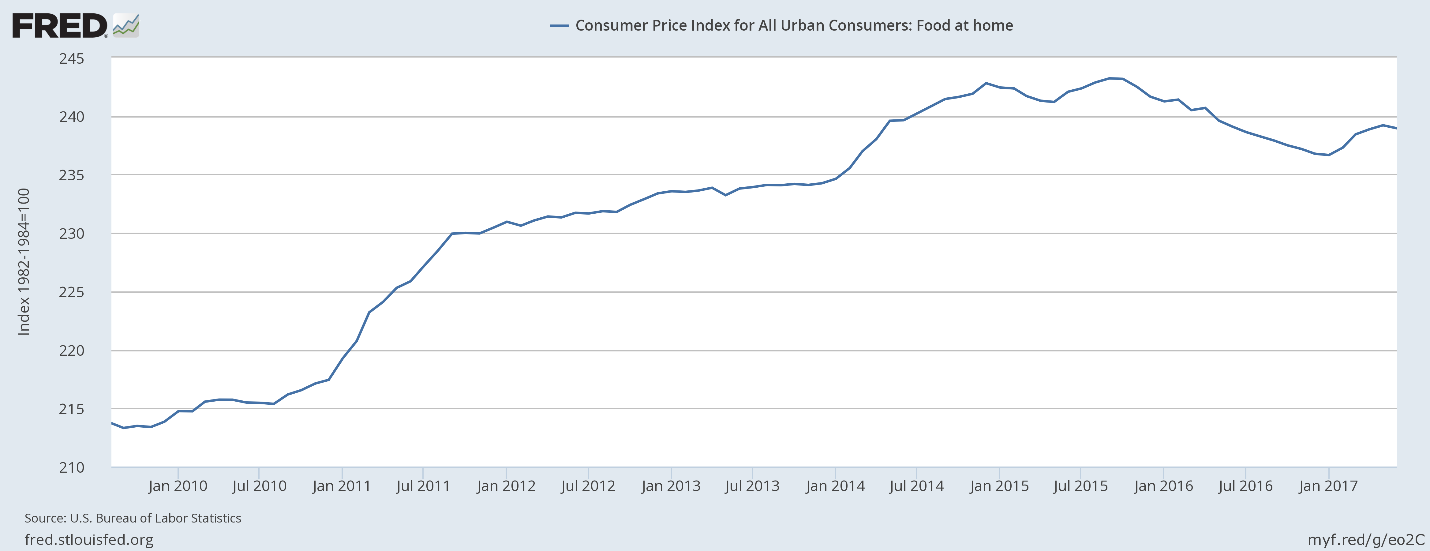I married well.
After seeing a recent stat that 41% of first marriages end in divorce, I count myself lucky. I managed to find a mate who is smart, funny, responsible and compassionate.
And he loves to cook!
I picked up some basic cooking skills throughout high school and college. I can make grilled cheese, boil an egg and bake a mean chocolate cake for someone’s birthday. But I don’t stray too far from those easy recipes and skills.
On the other hand, my husband is the one in our family who makes the bulk of our meals. He’s the one who can explain the different cuts of beef at the grocery, and he’s the one who knows when to use dill and when to use rosemary. (I try to stay away from the spice rack completely.)
If food prices continue to shift the way they have over the past year, I think we will see more people like my husband cooking amazing meals at home rather than going out to eat … and that’s going to create some fantastic investment opportunities if you know where to look.
Back in the Kitchen
On Friday, the government announced that the consumer price index (CPI) was unchanged for June, while economists were expecting inflation to tick up 0.1%. The 12-month CPI has dropped to 1.6% from 1.9% and is well off its five-year peak of 2.7% reached in February.
There’s a lot of hullabaloo going on right now about whether the Federal Reserve will lift rates yet again this year and whether the slowdown in inflation is far more than temporary, as the Fed has been claiming.
But I don’t care about the Fed right now. If the Fed is going to act, it’s unlikely to be until December, and there’s a lot of data set to come out between now and December that could sway the Fed.
If you dig a little deeper into the CPI report, there was a great nugget of data that no one is really talking about … and that creates a great opportunity for astute investors.
The government reported that grocery prices (food at home) fell in June. As you can see in the chart from the Federal Reserve of St. Louis, the price of food purchased in a grocery and prepared at home has steadily dropped since peaking in September 2015. We experienced a small run-up earlier this year, but it appears that prices are rolling over once again and headed lower.

By contrast, the price of food purchased at restaurants has steadily risen over the same time period and shows little sign of relenting.

Technology has worked to reduce costs in food production by increasing crop output. Low gas prices have cut transportation costs as well. The end result: It is now cheaper to buy food at the grocery than it was in 2015.
Meanwhile, rising labor costs and skyrocketing rents have forced many restaurants to lift their prices just to eke out a profit, making it far more expensive to eat out.
The United States Department of Agriculture reports that food-at-home prices dropped 1.3% in 2016 from 2015 levels and are expected to rise between 0% and 1% in 2017. Food-at-restaurants prices jumped 2.6% in 2016 and aren’t slowing in 2017.
The Market Has Changed
The race is on to make a profit off what’s hitting your table for dinner. We’ve seen a surge over the past several years of meal-delivery services such as Blue Apron, HelloFresh, Plated and Home Chef. These companies are catering to families (particularly millennials) who are looking for the comfort of cooking at home while still getting a unique variety of meals — far more than my awesome grilled cheese sandwiches.
Earlier this summer, Amazon announced plans to acquire Whole Foods. Imagine if Amazon could streamline Whole Foods the way it has done its other businesses, bringing costs down and luring customers in.
And of course, we have Wal-Mart going head-to-head with Amazon, which could create a price war that works in favor of consumers.
The market has shifted in favor of the grocer over the restaurant. Prices are dropping for food in grocery stores while restaurants are raising their prices just to get above the cost of operating. Meanwhile, wages for most Americans are stagnating, making the choice an obvious one.
Investors should be wary of restaurants and take a new look at grocery stores such as Kroger or even watch for new opportunities driven by millennials. Profits Unlimited Editor Paul is definitely watching this mega trend and searching for unique opportunities created by this massive generation.
Preheat the oven. Sharpen the knives. Bust out the cookbook. It’s time to make dinner at home.
Regards,

Jocelynn Smith
Sr. Managing Editor, Sovereign Investor Daily
P.S. Another mega trend that Paul focuses on is the Internet of Things (IoT), which is predicted to be utilized in 50 billion devices by 2020. Early investors stand to reap tremendous rewards as this industry grows 8,000% or more in the coming years. To learn more about the IoT, click here.




